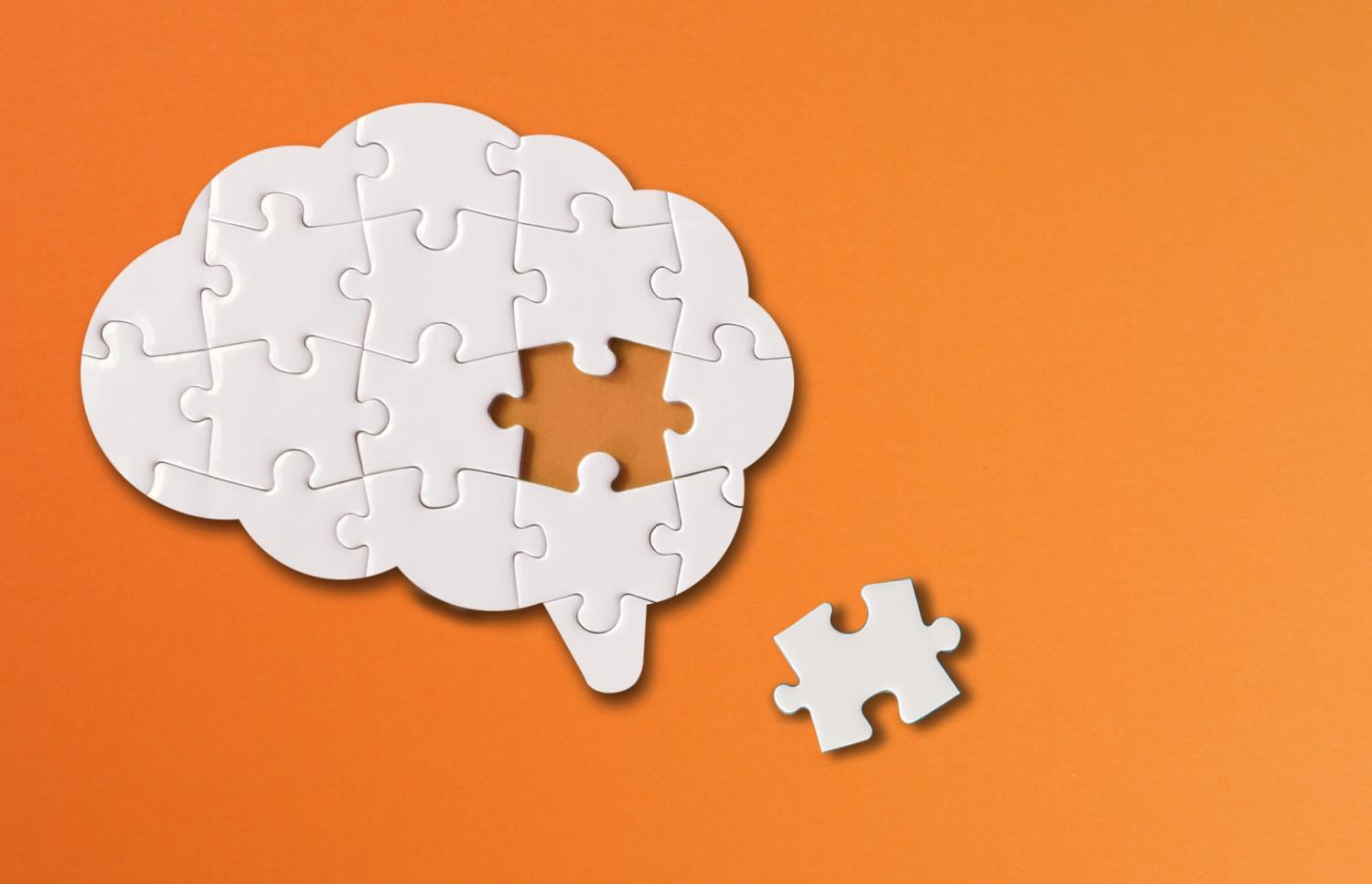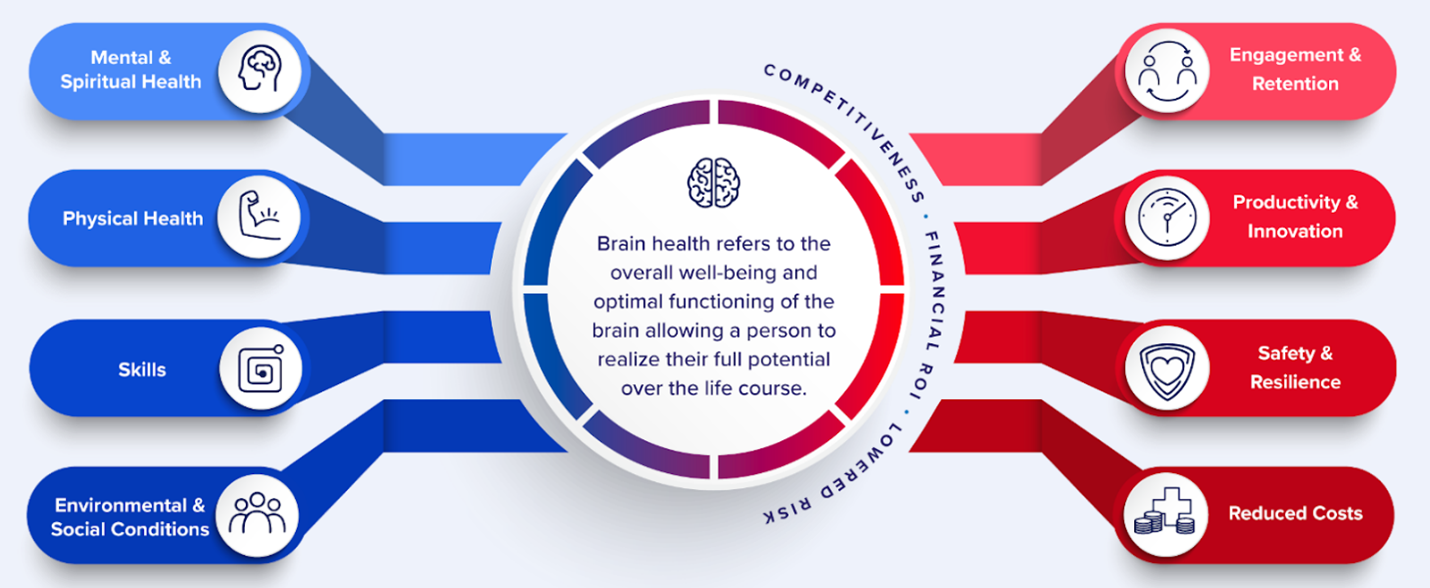Abstract
Brain science is the study of how the brain works and how it affects our behavior, cognition, emotions, and well-being. Brain science can also help us understand the modern economy, which is shaped by human decisions, interactions, and innovations. We are amid a global transition to an economy that relies on human cognitive resilience to flourish. Global coordination and attention are required to build this new brain economy for the benefit of people, the economy, and nature. Brain capital is an economic asset that prioritizes, integrates, and optimizes brain health and brain skills to accomplish socio-economic objectives. In other words, our collective brain power is a prosperity and national security asset.
Here we outline a four-step roadmap to drive the brain economy transition which will coordinate and utilize the respective strengths of public, private, and philanthropic actors.
Rethinking our economic model
The coming years are likely to be turbulent due to a myriad of factors or polycrisis, including an escalation in climate extremes, emerging public health threats, weak productivity, population aging with increasing dementia prevalence, declining birth rates, increases in global economic instability, and further weakening in the integrity of global democracy. Mental and brain disorders are a growing challenge which is already a drag on the world economy. The Institute for Health Metrics and Evaluation’s (IHME) Brain Health Atlas data shows that the burden of brain disorders is more significant than cardiovascular diseases or cancers. Neurological disorders affect 3.4 billion people worldwide. Mental health disorders alone are estimated to cost the global economy $5 trillion per year, and this is projected to rise to $16 trillion by 2030.
We recently published a review on the economic determinants of mental health. Evidence suggests neoliberal ideologies prioritizing economic optimization and continuous growth contribute to the promotion of individualism, job insecurity, increasing demands on workers, parental stress, and social isolation—a broad range of manifestations that are well-recognized to erode mental health.
Christine Lagarde, president of the European Central Bank, noted at the 2023 U.S. Reserve Bank’s three-day symposium that there is “no playbook” for the changing and complex global economy and society. She noted our economy is in a new age and past economic models may not be a good guide for our collective future. We believe the brain economy transition to boost brain capital, fueled by a renaissance in brain science, is a new economic model fit for the coming decades.
The brain economy is a global goal to stop and reverse the loss of brain capital. This economic transition is not just good for people but also for the economy and nature. This brain-based economic transition strategy was inspired significantly by the World Economic Forum (WEF) and McKinsey’s work on the nature-positive economy.
Brain capital provides a new lens for dealing with economic insecurity, productivity slow down, sustainability, gender equity, creativity shortcomings, as well as brain health which includes mental health, thereby affecting education.
A roadmap for the brain economy transition
In practice, how do nations start on the journey to the brain economy transition?
Below we outline a four-step approach to allow stakeholders to rapidly mobilize around a joint aspiration for their country.
- Develop a shared vision and mission, then explain and communicate.
- Identify and engage key drivers and champions.
- Leverage and scale up existing brain initiatives and innovations.
- Monitor and evaluate the progress and outcomes of the transition.
This step requires articulating the benefits and challenges of enhancing and protecting brain capital, to then inspire and mobilize collective action. It is important to target various audiences and stakeholders, using evidence-based and compelling narratives and messages and addressing potential barriers and objections.
Key stakeholders for the brain economy transition may include brain scientists, economists, policymakers, educators, entrepreneurs, civil society leaders, and media professionals. Building trust and collaboration among them is important.
In Box 1, we provide a primer on the brain economy intended to demonstrate how diverse stakeholders are key to developing a shared vision.
Box 1: Primer on the brain economy
The “brain economy” represents the idea that communities, societies, and countries contribute to economic stability and growth through their collective brainpower. In contrast to yesteryear, when markets were dominated largely by trade of goods, today’s global economy combines manufacturing with the knowledge of how to trade. It is an extension on the concept that we live in a “marketplace of ideas.” Today’s economy is one in which most new jobs demand cognitive, emotional, and social—not manual—skills, and in which innovation is a tangible “deliverable” of employee productivity.
“Brain capital” encompasses both brain health and brain skills as contributors to this brain economy. It is the currency of the brain economy. Advocates argue brain capital should be valued in the same way as gross domestic product (GDP) and road infrastructure.
One of the key challenges in building brain capital in the coming decades comes from artificial intelligence (AI). Despite the great potential of AI to enhance economic productivity, these algorithms have the potential for widespread brain manipulation via social media’s negative effects on mental health, the proliferation of mis- and dis-information (noted as a top risk by WEF in 2024), the emergence of what NATO describes as Cognitive Warfare, and the potential to hack brain-computer interfaces. These are all corrosive to our cognitive liberty—the right to self-determination over our brains and mental experiences—our right to both access and use technologies, and a right to be free from interference with our mental privacy and freedom of thought. UNESCO is very active in policy formation in this space. The UN AI Advisory Body is also a key public-private policy tool to reduce the risk of AI algorithms. As generative AI advances, it is critical to rapidly iterate on the best governance structures to optimize the value of AI to our brains and mitigate the risks.
Identify and engage key drivers and champions
Brain capital can be nurtured by actors across sectors and with different areas of focus. If global coordination is the problem of our time, then brain capital might be a common interest around which we can all work together. We outline a few examples below.
Reforming food systems
Reforming food systems is crucial to strengthening brain capital. Such reforms could create multi-trillion dollars of economic benefits every year according to a report from the Food Systems Economics Commission. Beyond the ecological destruction and greenhouse gas emissions, health costs alone related to failures in our food system add up to the bulk of current losses stemming from food-related non-communicable diseases such as diabetes, hypertension, cancer, and dementia. We concur and published a report in 2023 noting how good food is vital for brain health and necessitates major food system reforms. We collected evidence indicating the current system promotes unhealthy diets leading to non-communicable diseases and negatively impacts brain health (including mental health). Furthermore, it contributes to environmental degradation, chemical and plastic pollution, threatening planetary health, which is vital for human survival and well-being.
Engaging social media
The initiative must include social media companies. These companies provide products and services for billions of individuals around the world. While there are clearly benefits to these platforms, there is increasingly alarm and evidence for their negative effects on teen mental health. For example, Meta, the parent company of Instagram, was sued by 33 U.S. states over claims that youth mental health is endangered by their platform.
Considering gender-specific innovations
Investing in women’s health can yield enormous returns, and the cost of not investing in women’s health is significant. Women’s Health Access Matters (WHAM) and RAND have shown that investing an additional $350 million in research on women could generate returns of $14 billion to the U.S. economy. A report from McKinsey and the World Economic Forum suggests addressing the women’s health gap could potentially boost the global economy by at least $1 trillion annually by 2040. Brain health disorders, such as headache disorders, depression, and Alzheimer’s disease, disproportionately affect women. The report outlines the importance of scaling up women-centric health research, investment in health care start-ups and policy approaches such as reforming medical school curricula and workplace designs. These recommendations are significantly aligned to the Women’s Brain Project, a Swiss-based not-for-profit, and could align with the recently announced White House plans to scale up women’s health research in the United States. Given the abovementioned health services gap and the disproportionate propensity for brain diseases to affect women, investing in women’s health is likely to have an even greater impact on brain capital than increasing investments on men.
Partnering with patient advocacy organizations
The European Federation for Neurological Associations, a major advocacy organization for neurology patients and caregivers, recently noted that under the umbrella of brain capital, neurology patients, caregivers, and patient organizations can mobilize and influence change to support research and innovation, access to therapeutics, and services and supports, ultimately improving the quality of life of those affected (patients and caregivers) and in turn serve as a foundation for benefits to healthcare systems and the employment sector.
Meeting citizens where they work
Workplace brain health is key to driving productivity, creativity, and well-being in the workplace. The Business Collaborative for Brain Health, an UsAgainstAlzhiemer’s program (see Figure 1), is working vigorously on tools to promote this via a Brain Health Best Practice Scorecard and Guide, a consumer-friendly guide to science-based brain health solutions. Workplace brain health is critical to unlocking analytical thinking and creative thinking, the most important skills for workers in 2023 according to the most recent WEF Future of Jobs Report.
The role of neuroscience-inspired architecture
The built environment of workplaces where employees spend much of their lives is clearly vital. HKS Inc, an architecture firm, and the Center for Brain Health at The University of Texas at Dallas recently published their findings of a year-long study on brain health in workplaces. They highlighted key workplace affordances that optimize brain health and productivity, including focus, exploration and ideation, collaboration and co-creation, rest and reflection, and social connection. They also noted the importance of integrating brain health training with workplace habits and built environments together.
Engaging impact investors
Beyond traditional venture capital, angel investing, and private equity funding, we will need longer-term forms of investing. We suggest that impact investors with more “patient capital” (e.g., a 10–20 year time horizon such as public pension funds and sovereign wealth funds) are better suited for effective brain capital investments compared to politicians with a two-to-five-year time horizon and venture capital’s five-to-seven-year time horizon. Engaging patient capital pools in discussions around investing in the brain economy transition is key. Showing patient capital pools examples of existing initiatives providing patient capital to start-up companies will be helpful, e.g., the Alzheimer’s Disease Discovery Foundation, which is a venture philanthropy fund to accelerate Alzheimer’s disease diagnostic and drug and other therapeutic developments. Appendix 1 provides other examples of patient financial vehicles looking to achieve societal impact over 10+ years.
New economic approaches
The modern economy is a complex adaptive system that can be influenced by strategic actions that leverage its nonlinear dynamics and feedback loops. A productive approach to integrating brain science into the economics is to identify and implement brain-positive economy transition “sensitive intervention points (SIPs).” These are points in the economic system where a small or moderate intervention can trigger a large and positive change towards a more sustainable and resilient future. These points can be related to technology, psychology, social networks, policy, or other domains. They can also be critical tipping points, critical nodes, or critical windows of opportunity. Such analytic framing has not previously been applied to the brain economy and much can be learned from the climate field, e.g., the Net Zero Platform of The University of Oxford.
Leverage and scale up existing brain initiatives and innovations
Policymakers should promote existing programs that demonstrate the feasibility and impact of brain-positive solutions and create platforms and mechanisms for sharing best practices and lessons learned.
A recent study by the Institute for Health Metrics and Evaluation (IHME) Brain Health Collaborative quantified the proportion of nervous system burden that was potentially preventable by eliminating known risk factors for stroke, dementia, multiple sclerosis, Parkinson’s disease, encephalitis, meningitis, and intellectual disability. The analysis suggests that modifying 18 risk factors over a person’s lifetime—most importantly high systolic blood pressure (57% of disability adjusted life years (DALYs))—could prevent 84% of global DALYs from stroke. Additionally, estimates suggest that controlling lead exposure could reduce the burden of intellectual disability by 63%, while reducing high fasting plasma glucose to normal levels could reduce the burden of dementia by around 15%.
National-level brain health plans are a potential way of driving public-private-philanthropic collaboration around public policy and private-sector activities. The Swiss Brain Health Plan, launched in late 2023 with support from the then-Swiss President Alain Berset, provides a model to explore. It aims to value, promote, and protect brain health over the entire life course, and includes elements of clinical, public health, public education, research, and public-private innovation. Finland has a well-established brain health plan which is now integrating impact-investing approaches, such as procuring services based on outcomes rather than outputs, e.g., social impact bonds. The Finnish National Brain Health Plan is taking lessons from impact bonds across occupational wellbeing, fast employment and integration of immigrants, children’s welfare, advancing employment, prevention of type 2 diabetes, and support of elderly independence. Most nations around the world can develop such brain health plans which are tailored to their socio-cultural contexts.
The Davos Alzheimer’s Collaborative (DAC) exemplifies a public-private-philanthropic partnership (4P) driving a brain economy. DAC is a Swiss-based foundation and a U.S. 501c3 initiated by The World Economic Forum (WEF) and The Global CEO Initiative on Alzheimer’s Disease (CEOi). DAC aims to build an innovation ecosystem that will accelerate breakthroughs, develop, and scale promising solutions and equip healthcare systems globally.
The Forum and McKinsey recently published a pioneering paper on the role of 4Ps in driving climate and nature transitions, which inspired thinking and action for the brain-positive economic transition. As cross-sectoral and multistakeholder collaborations, 4P models are well suited to addressing complex brain economy challenges. Such challenges require deep, system-level transformation, which in turn requires an understanding of the needs and constraints of a broad set of actors, the ability to bring these actors together around well-defined objectives, the willingness to take a longer-term perspective, the capacity to run a robust day-to-day operation, and an appetite for experimentation. Appendix 1 outlines a summary of other 4P models aligned with a brain economy, and the World Economic Forum has provided pillars to help identify or assess priority areas of focus for these models.
Monitor and evaluate the progress and outcomes of the transition
Indicators and metrics are integral to capturing the multidimensional aspects of brain capital and providing feedback and incentives for improvement and adaptation.
The Global Brain Capital Dashboard provides a data-driven platform to help us prioritize the most key brain capital investments and policy foci. This dashboard assesses country-by-country measures of drivers, brain health, and brain skills and provides a model for within-country dashboard development.
Intra-governmental coordination is key to transition from a brain-negative to a brain-positive economy. Depression and anxiety, loneliness, Alzheimer’s disease, learning disorders, substance misuse disorder, long-haul COVID effects (such as “brain fog”), the toxic effects of air pollution on the brain, and even deaths of despair are all brain-based challenges. We have partial solutions to these issues already, however many challenges and solutions typically fall through the proverbial cracks because they cut across policy areas and sectors of government. We have previously outlined the importance of public-private brain capital advisory and task force-type mechanisms within governments. We need a coordinated approach to measure, track, manage, and ultimately prevent these issues. Such an approach could boost economic dynamism through reduced suffering, optimized brain performance and productivity, and new industries.
A special note on sustainability
Chemical and plastic research and public policy are key to stopping and reversing the loss of brain capital. For example, paraquat is heavily linked to Parkinson’s disease, and plastic pollution is linked to brain toxicity and Parkinson’s disease. The WEF had an important dialogue at their 2024 WEF Annual Meeting on the Global Plastics Treaty. Therefore, brain capital is closely linked to the United Nations One Health approach to improving the health of people, animals, and ecosystems.
Green brain capital is crucial to driving a sustainable future, given it subserves green skills and ecological intelligence. According to the UN, green skills are the knowledge, ability, values, and attitudes needed to live in, develop, and support a sustainable society. Ecological Intelligence is an individual’s ability to apply what they learn about their impact on the environment to make changes in their behavior and live more sustainably. Therefore, mentally healthy schools are vital to allow children and youth to develop such skills, knowledge, and awareness. We also launched the Flow-Mental Pollution Assessment at COP 28 in Dubai to help guide consumers and companies toward more sustainable product purchasing and development.
Taken together, brain capital is intricately linked to all the United Nations Sustainable Development Goals (SDGs). We explained in a recent Rice University Baker Institute for Public Policy Research Paper and our 2023 UN General Assembly Science Summit report, supported by the California Government, how brain capital can drive progress on SDGs and provide a new vector to help advance these ambitious goals which are described by the UN as “in peril.” This is critical now, as many actors are beginning to design the post-SDG agenda, as the SDGs will end in 2030.
The brain economy is a necessary transition for the well-being of people, the economy, and nature, regardless of industry, sector, or country. It is time to coordinate, share, and refine our tools and drive toward a brain economy transition together.
Appendix
Basic neuroscience
Early childhood
Education
Mental health
- HopeLab
- BD2
- Mental Wealth Initiative
- Stavros Niarchos Foundation (SNF) Global Center for Child and Adolescent Mental Health
Brain science and business
Brain health
- Harvard McCance Brain Health Center
- Cohen Veterans Bioscience
- Weill Neurohub
- Brain and Mind Institute at Aga Khan University
- Lighthouse Life Science
- Centre for Aging + Brain Health Innovation (CABHI)
- Global Brain Health Institute
- AARP Global Council on Brain Health
- Brain Research Africa Initiative (BRAIN)
- Social Impact Partners
Alzheimer’s and Dementia
-
Acknowledgements and disclosures
The Brookings Institution is financed through the support of a diverse array of foundations, corporations, governments, individuals, as well as an endowment. A list of donors can be found in our annual reports published online here. The findings, interpretations, and conclusions in this report are solely those of its author(s) and are not influenced by any donation.
Eyre has received travel support from the Euro-Mediterranean Economists Association and is a contractor with Meadows Mental Health Policy Institute. Njamnshi is founder and CEO of the Brain Research Africa Initiative, and Vradenburg is the founding chairman of the Davos Alzheimer’s Collaborative and the chairman of Us Against Alzheimer’s. The authors did not receive financial support from any firm or person for this article or, other than the aforementioned, from any firm or person with a financial or political interest in this article. Other than the aforementioned, the authors are not currently an officer, director, or board member of any organization with a financial or political interest in this article.
The Brookings Institution is committed to quality, independence, and impact.
We are supported by a diverse array of funders. In line with our values and policies, each Brookings publication represents the sole views of its author(s).








